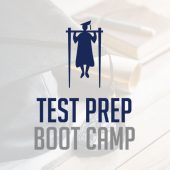Should you prepare for the PSAT?
After students get their PSAT scores back, they don’t always get a lot of direction about what to do next. If you’re lucky, your school might host a meeting to go over what the scores mean, but most schools are overburdened with other things. You’ll probably get the score report that shows your PSAT score, your National Merit Selection Index, and a breakdown of which questions you got right and which ones you missed.
W ithout much direction on what to do, it’s little wonder that students tuck the score reports into their backpacks and usually forget about them. You won’t have a copy of the actual test to look at, so you can see exactly which questions you missed. Besides, for 95% of students, the PSAT is really just a sneak peek at what they can expect for the SAT. It’s not going to directly impact their college admissions, so they’re better off focusing on the SAT or ACT.
ithout much direction on what to do, it’s little wonder that students tuck the score reports into their backpacks and usually forget about them. You won’t have a copy of the actual test to look at, so you can see exactly which questions you missed. Besides, for 95% of students, the PSAT is really just a sneak peek at what they can expect for the SAT. It’s not going to directly impact their college admissions, so they’re better off focusing on the SAT or ACT.
There are some definite steps you should take after you get your PSAT scores back whether you’re going to prepare for the next PSAT or not. The bigger question is whether or not it’s worth it for you to study specifically for the PSAT your junior year. A preparation program dedicated to the PSAT is likely going to cost $1000 or more, so are you better off spending your money preparing for the PSAT or the SAT?
What is National Merit?
You’ve probably heard the term National Merit at some point. Many people I talk to aren’t really sure what that is.
The National Merit Scholarship Corporation is an entity that offers merit-based scholarships, but the process is a little confusing. The NMSC itself awards $2500 scholarships every year to a limited number of National Merit Scholars; however, individual universities and a number of corporations award scholarships to National Merit Scholars as well.
Qualifying as a National Merit Scholar requires scoring above a certain cutoff on the PSAT in a student’s junior year. The cutoff is different for each state. It’s approximately the top 1%. Students achieving that score are named Semifinalists. They have to complete some documentation and submit a confirming test score in order to become Scholars. As long as they meet the deadlines, almost all of the students achieving Semifinalist qualify as Scholars.
The top 3% of students nationally will qualify as Commended students. Scoring in the 97th percentile is an excellent achievement of its own and can help with merit-based scholarships; however, it is the end of the process for those students.
How is the NMSI calculated?
The National Merit Selection Index (NMSI) is used to determine the cutoffs. The idea is that the PSAT counts math as 50% and reading and writing as 25% each for the composite score. This gives an advantage to mathematically inclined students. Instead, the NMSI, apportions an equal 33% to each section.
The easiest way to see the connection is to take your Reading and Writing score, double it, add it to your Math score, and drop the zero. For example, if you scored a 1240 on the PSAT with a 610 in Reading and Writing and a 630 in Math, your NMSI would be 185 (610 x 2 = 1220, 1220 + 630 = 1850, drop the zero = 185). The interesting thing is that if you reverse those scores–630 in Reading and Writing and 610 in Math–your NMSI is 187 (630 x 2 = 1260, 1260 + 610 = 1870, drop the zero = 187). The same composite scores can have different NMSI scores.
Part of you may think, wait a minute, isn’t that a little unfair against students who do well in math?
Maybe. In some ways, the system is always going to have advantages for some groups over others. The NMSI recalculates the score to make it the least unfair from a purely statistical perspective.
Should you prepare for the PSAT?
Which brings us to the central question of whether or not it’s worth it for you to prepare specifically for the PSAT.
The Commended cutoff for the class of 2018 is 211. Although the Semifinalist cutoff varies by state, it usually hovers around 220 and can be anywhere from 212 to 223. Compass Education Group provides a reliable list of cutoffs and their predictions for the class of 2019. Check it out to see what you’d have to score.
As a general rule, if your NMSI is a 190 or above, it’s probably worth it to prepare for the PSAT your junior year. You’re within 21 points of the Commended cutoff. Although Commended itself won’t qualify you for scholarship money, it does a lot to set you apart from other applicants. You’ll also be honored and recognized by your school and school district. More importantly, you’ll be doing deep practice that will transfer to your SAT as well. If you take the SAT in November or December of your junior year, you’ll be able to use all of the work you do for the PSAT on that test.
Of course, it’s all a bit of a risk. You’re going to get one shot at the PSAT. The margin of error for Semifinalist is razor-thin, and simply misbubbling can cost you the score. Just one or two questions can make the difference, especially at the higher end of the scores. That said, if you are at that upper end already, the potential benefits of National Merit Scholar in addition to the help the preparation will give you on the SAT are well worth the investment to prepare for the PSAT in your junior year.
If your NMSI is below 190, you’re probably better off focusing your preparation on the SAT or ACT. Hard work can close the gap, but the hard work will pay off more definitively with a 1450 SAT score than a 1420 PSAT.
Navigating college admissions and preparation is tricky. Contact us if we can help. Our Introductory Consultation is a great way to map out a plan, and students completing our Test Prep Boot Camp are consistently raising the composite scores 120-150 points on the SAT and 3-5 points on the ACT.






